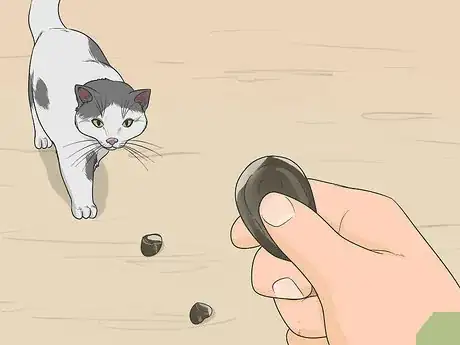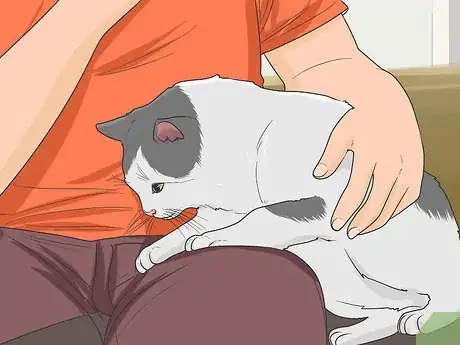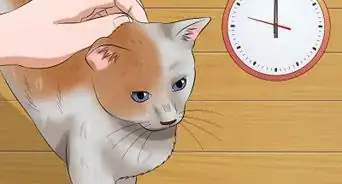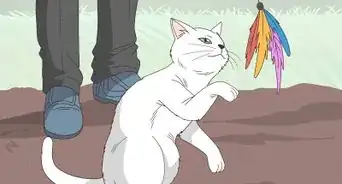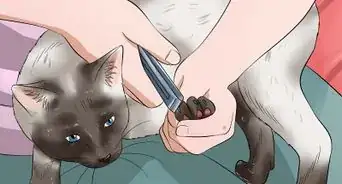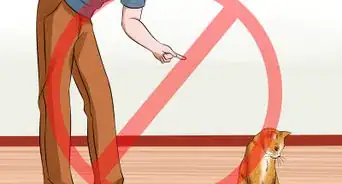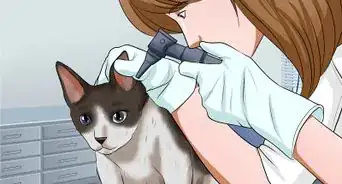This article was co-authored by Brian Bourquin, DVM. Brian Bourquin, better known as “Dr. B” to his clients, is a Veterinarian and the Owner of Boston Veterinary Clinic, a pet health care and veterinary clinic with three locations, South End/Bay Village, the Seaport, and Brookline, Massachusetts. Boston Veterinary Clinic specializes in primary veterinary care, including wellness and preventative care, sick and emergency care, soft-tissue surgery, dentistry. The clinic also provides specialty services in behavior, nutrition, and alternative pain management therapies using acupuncture, and therapeutic laser treatments. Boston Veterinary Clinic is an AAHA (American Animal Hospital Association) accredited hospital and Boston’s first Fear Free Certified Clinic. Brian has over 19 years of veterinary experience and earned his Doctor of Veterinary Medicine from Cornell University.
There are 12 references cited in this article, which can be found at the bottom of the page.
wikiHow marks an article as reader-approved once it receives enough positive feedback. This article received 16 testimonials and 90% of readers who voted found it helpful, earning it our reader-approved status.
This article has been viewed 341,673 times.
Many cities are full of stray cats and it is estimated that there are over 30 million stray, abandoned, and feral cats in the US alone.[1] Many municipalities are unable or unwilling to take any action, beyond capturing a few cats to euthanize them, due to a lack of time, money, and interest. Because there is little help to stray cats and their risk of death from injuries, disease and poor nutrition, you may feel compelled to help a wild cat or kitten yourself. This process may take some time, so you need to be patient, but it can be very fulfilling to befriend and help a cat in need.
Steps
Luring a Wild Cat to You
-
1Differentiate between a stray cat and a feral cat. A stray cat is someone’s former cat that no longer has a home; a feral cat was born in the wild and is a cat that is wary of humans and generally isn't adoptable due to not being adapted to humans.[2]
- You may have success at befriending a stray cat; a feral cat probably not although it may become acclimated to your presence.
- Whether you have a stray or a feral cat around your home, capturing (or trapping) the cat and bringing it to the veterinarian for vaccinations and to be spayed or neutered is an excellent civic duty. Feral cats that are “fixed” can be released back where you found them.[3] You’ll have the satisfaction of knowing they won’t be able to reproduce and contribute to the feral cat population.
-
2Take safety precautions. Wild cats can be unpredictable so you will need to practice some safety precautions as you are trying to befriend it. Cat bites usually become infected, some very seriously, so you will need to wear long sleeves and pants when trying to befriend the cat.[4]
- Another concern is rabies in a cat of unknown vaccination status. Use caution and common sense. If the cat starts to hiss or growl, looks sick (runny nose or eyes, scabs, sneezes/coughs, breathes heavily), or acts bizarrely don’t try to befriend it.[5] Call animal control and retreat to your home.
Advertisement -
3Begin befriending the cat. If the cat appears healthy and isn’t acting defensive and mean towards you, you can try befriending it. Find a place where the cat usually stays, and wait nearby until the cat reaches its spot.
- Sit down or lie down, if you can, or at least crouch. The cat will find you much less intimidating that way. Stay there for a while. Teach the cat you won't hurt it.
- This should be a fair distance away, 10 feet or so, so you don’t intimidate the cat.
-
4Offer the cat food. Try leaving out some smelly cat food (wet) or even a can of tuna to attract the cat while you are waiting for it to arrive. You want to get the cat to associate you with something good, namely a free lunch.[6]
- You only need to leave out smelly food the first day. After this leave out a little dry kibble to keep the cat coming back for more.
- Cats are not as food-motivated as dogs. If offering food does not work, try giving them attention. Toys or small, moving things will encourage them to approach you.[7]
-
5Continue putting little bits of tuna closer and closer to you. Each day the cat comes to eat, move your spot another foot closer. If you hold the cat food in your hand for a while, your scent will be on it, too. This won't discourage the cat from eating it, but it may cause the cat to associate you with food, which is good in general. Put out your hand to let the cat sniff it.
-
6Show the cat some affection. Eventually the cat should get close to you then put out your hand let the cat sniff your hand. Continue feeding the cat, and sitting nearby quietly, and eventually you should earn its trust to the point it will come up to you for food and gentle pats. Don't expect this to happen right away. Don't expect them to even eat any of the tuna right away.
- Although you want to make friends, staring at the cat can be misunderstood as a sign of aggression. When it comes to befriending a cat, less is more. Sit quietly, sideways on, and ignore the cat. Let them come to you, but you can make yourself more attractive by scattering treats close to your feet.[10]
- Don't be discouraged if the cat does not immediately approach you. Not all cats want to be touched and some may just be happy to be in your presence.[11]
Taking Care of a Wild Cat or Kitten
-
1Help find the cat's owner. Ask around your neighborhood to see if anyone has lost their cat. Cats that get outside can get lost or roam around. Make some calls to local veterinary clinics and pet stores to see if anyone is missing a cat; taking a photo with your phone and making up fliers or posting to social media sites can also help reunite a stray cat with its owners.
- If the cat is feral instead of stray, it will not have an owner to be returned to.
-
2Get the cat checked out by a veterinarian. Once you are able to approach the cat and pet it, make an appointment with your veterinarian to have the cat examined and neutered or spayed. If funds are tight, call your local humane society to see if there are any funds available to assist with these costs.
- The cat will have a tiny bit of blood drawn to test for the feline leukemia virus. If the results are positive your veterinarian will discuss options with you, which include isolating the cat from other cats for its life or euthanasia. If it is negative, a fecal sample will be looked at to determine if the cat has intestinal parasites and it will be given the appropriate medication.
- In addition, the veterinarian will check for fleas and ticks and treat if needed. Vaccines (rabies, distemper, and possibly feline leukemia) will be given and its sterilization operation will be performed. A microchip may also be placed under the skin if so desired. This is highly recommended.
-
3Find a home for the cat or kitten. Now you will have a healthy pet to take home after its operation and vaccinations. Your hard work will pay off knowing you have saved another cat from a harsh life on the street. Either adopt the cat yourself or find another loving home for it to go to.[12]
Expert Q&A
Did you know you can get expert answers for this article?
Unlock expert answers by supporting wikiHow
-
QuestionWill food encourage a cat to trust me?
 Brian Bourquin, DVMBrian Bourquin, better known as “Dr. B” to his clients, is a Veterinarian and the Owner of Boston Veterinary Clinic, a pet health care and veterinary clinic with three locations, South End/Bay Village, the Seaport, and Brookline, Massachusetts. Boston Veterinary Clinic specializes in primary veterinary care, including wellness and preventative care, sick and emergency care, soft-tissue surgery, dentistry. The clinic also provides specialty services in behavior, nutrition, and alternative pain management therapies using acupuncture, and therapeutic laser treatments. Boston Veterinary Clinic is an AAHA (American Animal Hospital Association) accredited hospital and Boston’s first Fear Free Certified Clinic. Brian has over 19 years of veterinary experience and earned his Doctor of Veterinary Medicine from Cornell University.
Brian Bourquin, DVMBrian Bourquin, better known as “Dr. B” to his clients, is a Veterinarian and the Owner of Boston Veterinary Clinic, a pet health care and veterinary clinic with three locations, South End/Bay Village, the Seaport, and Brookline, Massachusetts. Boston Veterinary Clinic specializes in primary veterinary care, including wellness and preventative care, sick and emergency care, soft-tissue surgery, dentistry. The clinic also provides specialty services in behavior, nutrition, and alternative pain management therapies using acupuncture, and therapeutic laser treatments. Boston Veterinary Clinic is an AAHA (American Animal Hospital Association) accredited hospital and Boston’s first Fear Free Certified Clinic. Brian has over 19 years of veterinary experience and earned his Doctor of Veterinary Medicine from Cornell University.
Veterinarian
-
QuestionIs milk a safe alternative for food?
 Pippa Elliott, MRCVSDr. Elliott, BVMS, MRCVS is a veterinarian with over 30 years of experience in veterinary surgery and companion animal practice. She graduated from the University of Glasgow in 1987 with a degree in veterinary medicine and surgery. She has worked at the same animal clinic in her hometown for over 20 years.
Pippa Elliott, MRCVSDr. Elliott, BVMS, MRCVS is a veterinarian with over 30 years of experience in veterinary surgery and companion animal practice. She graduated from the University of Glasgow in 1987 with a degree in veterinary medicine and surgery. She has worked at the same animal clinic in her hometown for over 20 years.
Veterinarian
-
QuestionHow can I pet a wild cat with kittens?
 Pippa Elliott, MRCVSDr. Elliott, BVMS, MRCVS is a veterinarian with over 30 years of experience in veterinary surgery and companion animal practice. She graduated from the University of Glasgow in 1987 with a degree in veterinary medicine and surgery. She has worked at the same animal clinic in her hometown for over 20 years.
Pippa Elliott, MRCVSDr. Elliott, BVMS, MRCVS is a veterinarian with over 30 years of experience in veterinary surgery and companion animal practice. She graduated from the University of Glasgow in 1987 with a degree in veterinary medicine and surgery. She has worked at the same animal clinic in her hometown for over 20 years.
Veterinarian The first consideration must be the welfare of the kittens. If the mother is intolerant of people, then approaching the den will upset her and could lead to abandonment of the kittens. If she is tolerant of people, then help her get used to your presence by leaving offerings of food. Once the kittens are 2-3 weeks old, this is the ideal time to stroke them and start socializing them with people. Distract the mother with food and gently stroke the kitten, but without disturbing the nest too much. As the kittens get older and venture out, they are then more likely to approach you for food and petting.
The first consideration must be the welfare of the kittens. If the mother is intolerant of people, then approaching the den will upset her and could lead to abandonment of the kittens. If she is tolerant of people, then help her get used to your presence by leaving offerings of food. Once the kittens are 2-3 weeks old, this is the ideal time to stroke them and start socializing them with people. Distract the mother with food and gently stroke the kitten, but without disturbing the nest too much. As the kittens get older and venture out, they are then more likely to approach you for food and petting.
Warnings
- Remember always to wash your hands thoroughly after touching the cat until you’ve had a chance to bring it to the veterinarian.⧼thumbs_response⧽
- Remember, only adopt a cat if you're willing to take care of it for its whole life, or find it another home. If you need to find it another home, it's best to find someone to adopt it, not to take it to a pound. These tend to be overrun by animals, especially cats, and may be forced to put down cats if they don't have any more room. So even if they don't specifically put down your cat, you may cause another one to be put down.⧼thumbs_response⧽
- Never run towards any cat. It will find this as aggressive behavior and it may try to bite or scratch you.⧼thumbs_response⧽
- Refrain from posting about the cat in question online. It may be claimed by its owner that way but it can also be claimed by poachers, hoarders, people who use cats in dog rings, and people who sell cats to be tested on. If you really want to put an add online don't post a picture of it or describe it. The true owner should be able to describe it to you.⧼thumbs_response⧽
- If the cat is aggressive, don't try to befriend it. Even if you manage, it will still be a wild cat, and may be nasty.⧼thumbs_response⧽
References
- ↑ https://www.humanesociety.org/resources/pets-numbers
- ↑ https://www.alleycat.org/resources/feral-and-stray-cats-an-important-difference/
- ↑ https://www.aspca.org/adopt/feral-cats-faq
- ↑ https://pets.webmd.com/cats/news/20140209/cat-bites-may-lead-to-serious-infections-hospitalizations
- ↑ https://pets.webmd.com/cats/rabies-cats
- ↑ https://pets.webmd.com/cats/features/how-to-bond-with-a-cat#1
- ↑ Brian Bourquin, DVM. Cat Behavior Trainer. Expert Interview. 20 December 2019.
- ↑ Brian Bourquin, DVM. Cat Behavior Trainer. Expert Interview. 20 December 2019.
- ↑ https://www.petmd.com/cat/slideshows/cat-hissing-7-things-might-be-blame
- ↑ Pippa Elliott, MRCVS. Veterinarian. Expert Interview. 24 August 2020
- ↑ Brian Bourquin, DVM. Cat Behavior Trainer. Expert Interview. 20 December 2019.
- ↑ https://www.petfinder.com/pet-care/giving-up-your-pet/tips-finding-home-pet/
- ↑ https://pets.webmd.com/cats/cat-toys#1
- ↑ https://www.aspca.org/pet-care/general-pet-care/spayneuter-your-pet
About This Article
To befriend a wild cat or kitten, start by sitting or crouching 10 feet away from where you usually see the cat so you don’t scare it away. You may also want to place a can of wet food nearby to attract the cat and help it associate you with something positive. Then, move 1 foot closer to it each day, but move back a few feet if the cat hisses at you or pulls its ears back. Once the cat is close enough, put out your hand and let it sniff you. Repeat this daily until the cat comes up to you and allows you to feed and pet it. For tips from our Veterinary co-author on how to care for a wild cat or kitten once you’ve gained its trust, read on!





